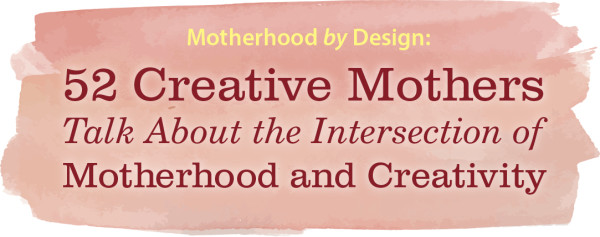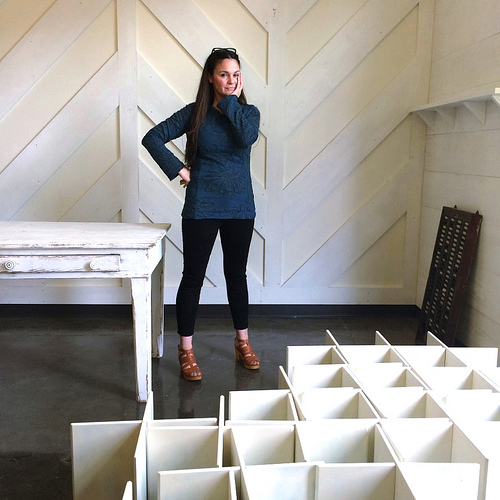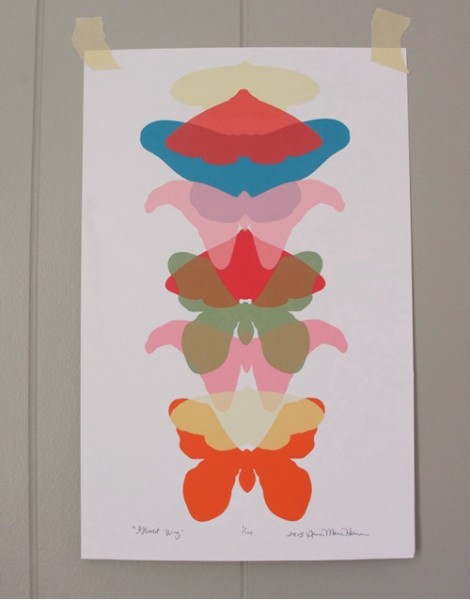
Welcome to Part Two of this special four-part Motherhood by Design interview with Anna Maria Horner. You can find the previous post here:
“You can’t just have a desire or a knack for something. You have to be a businessperson to do it well or have a good understanding of it, so I kind of felt like I earned a little bit of a business degree.”


You were in school when your first child, Juliana, was born. Did you have a creative business at that time, or did you start one after you graduated?
Let me think about it. Right after Juliana was born, I started making dresses for a local shop - there was a shop that opened up on campus, and it was kind of new and unique. They sold used jeans and they also started selling some clothes. They were selling used jeans before anybody had that idea, which was pretty cool! I can’t even remember what made me decide I should see if they wanted me to make them some dresses.
I was just making some things for myself and I figured that I could find materials, and if I could make them inexpensively enough, I could probably earn money. Juliana was probably about 1.5 or 2 years old at the time and I was also waiting tables and going to school 15 to 18 hours a week.
So I didn’t think I was really building a business as much as I was making some extra money. It wasn’t necessarily something I intended to keep up with because I was still trying to move towards earning my fine art degree and becoming a fine artist. My husband and I got married when Juliana was 18 months. He took a few extra years to finish his degree and I look back and have no idea how I actually finished mine in 4.5 years.
What is your husband’s degree in?
Computer science, but when I met him, he was an acting major and then he switched to being a guitar major. And then after we had Juliana, I think that I was far enough along in my art degree that we thought, well, one of us needs to make money! We have a guitar major and an art major and the art major is almost about to graduate. You better switch to something else. He earned a computer science degree, which was good.
He got that degree a few years later. So things just kept shifting based on what was coming up next.
Once you graduated from college, did you continue making dresses for the college shop?
No, I turned the dressmaking thing into a business with my mom, knowing that my husband had a few years left to finish that degree. We weren’t going to be leaving Knoxville (which is where we were) anytime soon and I was anxious to scale the dressmaking business because I enjoyed it and it was doing well with that little shop and I thought, “Well, why don’t I just make a wholesale price on this? I should sell them myself,” and I look back now and think about how naïve and also gutsy it was to invite all those extra expenses and have my own shop!
That’s what we did. It was right around the time my mom decided to retire from nursing, so we did it together. We had a shop called the Handmaiden where I designed that same little line of dresses and of course we had other shapes and pieces but I would design them and we would both sew them together in the shop and we definitely over-extended ourselves in the space available in that first shop.
So we filled it up with other things. We bought other lines of clothing and we took consignment from probably about 30 different artists and makers who did everything from jewelry to hand-painted furniture. It was really kind of ahead of its time 30 – well, 20-something years ago.
This was before online shopping happened. It was before people were combining clothing and furniture and jewelry into one shop and so I like to think of it as being a little ahead of its time, but it was also ahead of its time in terms of having a platform for making money because we didn’t make any. We had a ton of fun and covered our expenses but the eventual reality of that situation was that being the designer as well as running everything and working in the store fulltime was too much.
So my designing suffered and it was really hard to be creative and do what I felt like was what I wanted to do creatively, just because I was so bogged down with running the shop and worrying about paying rent and all those sorts of things.
So we got out of a five-year lease two years later and I paid heavily for doing it. I paid a $20,000 fee I think for breaking the lease. It was a struggle, but I was very young. I was only 23 when we opened the shop – but I decided that I just really had to get out of the retail business because it was just so physical and taxing.
We had also had our second kid in that store. So we opened the store after I had graduated and when Juliana was three, and then I had Nicholas there and so he was just a baby when we closed shop. I switched back to wholesale and just found more stores to carry my line, which of course took me years to realize that well, maybe that’s what I should have done if I wanted to make money or scale the wholesale business and not necessarily open a retail shop.
But there are all sorts of avenues and all of it taught me something. I learned a ton by having a retail business. One thing was it was not the time in my life to do that with a young family, and the second thing was that you have to be a businessperson to do that. You can’t just have a desire or a knack for something. You have to be a businessperson to do it well or have a good understanding of it, so I kind of felt like I earned a little bit of a business degree.
I chalk it all up to success because it taught me something. Whether or not it was business success or not, it was an education.
You’ve always been building your creative business and adding children to your family at the same time. So how do you balance your creative work with your mothering and how has that changed over time?
Again, I was always trying to acclimate to the environment, which is why the Handmaiden started. I was thinking well, my husband is working on his degree. We’re not leaving Knoxville. My dress business is going well. Let’s do that here and then I recognized that it wasn’t working for where we are right now. So I thought “let me take it back home,” and then I kept doing that for a few more years. We made the move to Nashville when I was pregnant with Joseph, our third child, a few years later in ’99. We moved so my husband could take his first better earning job after his graduation. It was the first time I analyzed what I could do as a supplemental income instead of our only income.
Oh, that’s a big shift.
It’s a huge shift because it allowed me to have a little bit more risk-taking and not just think OK, is the lemonade going to sell? How much is that going to leave me with at the end of each day?
So that was when my husband and I actually started investigating the process of me being a freelance designer, because my process had always been make it, sell it, make it, sell it, make it, sell it. It was very exhausting.
So I kept designing and making, but I found new ways to do it. Rather than selling to shops wholesale, I did social events, which now they call “pop-up shops.” Again, this was like 15 years ago. No one had heard the term “pop-up shop.” I was meeting people in Nashville and they would find out what I do, that I had this varied set of skills of either making handbags or clothing or painting furniture, or making paintings or art, and so I would pair up with some other designers and we would just host the night at a friend’s house where we had drinks and hors d'oeuvres. It was just a pop-up shop!
People would come and drink and buy and I could make between $2,000 and $4,000 in a night and I would – but it was a lot of work. But I was interspersing it between all the childcare and pregnancy and nursing. I was trying to be a good housewife and all those sorts of things. So that was the time when I was making, but it was on a much more flexible schedule as I had time between my mothering.
And I did not attach to a store or an expectation of a shop owner taking my wholesale goods on a specific date, so I had interjected some flexibility. I thought to myself I’m just going to go home and work on things and when I feel like I’ve got enough, I’m going to find someone to host the whole shopping night. So that was pretty cool and fun and I did that for a couple of years and it allowed me to sort of experiment with types of products that I wanted to create beyond clothing and accessories and just make some fine art as well.
I started feeling that maybe what I loved about it was the process of designing, because the physicality of sitting in a corner and making things for the rest of my life was hard. It was hard being my own little factory. There’s a beauty in the repetition, which I already experienced by making a clothing line.
It was funny when I look back and realized that when we ordered labels for our clothing line, the Handmaiden, I ordered them in a 5000-lot of clothing labels to put into garments. I remember doing a count of how many labels I had left when we stopped doing that line, and I only had a couple of hundred labels left. So it occurred to me that we had made close to 5,000 garments, and just done it ourselves. In three years, and I don’t know what that adds up to be, but there were times when I made up to 20 dresses a day.
So at that time, you were trying to get out of manufacturing and into just designing?
Yes, I was doing the more fine art-type things and less clothing. I was changing it up more and making more one-of-a-kind pieces. I really loved the interaction between myself and the customer and so it all sort of translated into just finding a way to keep designing, but not necessarily manufacturing everything myself. That’s when licensing came into the picture and I started doing more surface textile design.
I exhibited at Surtex and it was something that, again, because I had the benefit of my income as being a supplemental one to my husband’s, we were both making a commitment to take a risk. We had to invest money for exhibiting – and we just said that this seems like it could earn me something.
And if I got the right manufacturing partners, then I wouldn’t have to have a ton of them for it to go well. So we just agreed that we would invest in doing Surtex for five years, whether or not I was making any money - we would make that investment for five years and analyze.
Essentially by the fourth year, I was earning enough that I didn’t feel like I needed to go back, but I did do it that fourth year. But that whole process of licensing and finding the right companies to work with involved doing a lot of things that I didn’t care about, that I didn’t feel fulfilled by. Designing paper partyware isn’t something that I ever aspired to do, but I made $10,000 a year just in paper napkin designs.
So essentially what I was doing was trying to build my brand and gain experience with different companies and build my portfolio. It was great to also be able to earn a little money along the way. At one point I was working with about 24 different companies, doing everything from paper partyware to wallpaper, and really random little gift items that I wasn’t especially interested in. It wasn’t until I got asked to do fabric that I really was excited - I didn’t really know that fabric companies use freelance designers.
*****
Links to the complete series of interviews with Anna Maria are below:
You can find Anna Maria Horner in the following places:
Website: AnnaMariaHorner Facebook: Anna Maria Horner Instagram: annamariahorner Craft South: CraftSouth.com

